2018 年云南昆明理工大学英语考研真题
Part I Structure and Vocabulary
( 15 points )
Directions:Inthispart,therearefifteenincompletesentences.Foreachsentence
four alternatives A, B, C or D are given. Decide which of the alternatives best
completes the sentence and mark the corresponding letter on your ANSWER SHEET.
C. see
D. appears
B. appeared
C. appearing
B. being seen
When ______ at the door, she was given a warm welcome.
A. appear
Mr. Lee is far too wise a man not ______ that.
A. seeing
The residents, ______ had been damaged by the flood, were given help by the Red Cross.
A. all their homes
C. all of whose homes
______, I must do another experiment.
A. Be it ever so late
C. It be ever so late
I wish ______ to Stockholm when I was in Sweden. I hear it’s a beautiful city.
A. I went
D. to have gone
B. It is ever so late
D. So late it be ever
B. all whose homes
D. all of their homes
B. I had gone
D. to see
C. to go
1.
2.
3.
4.
5.
6.
7.
8.
9.
B. has known
C. shouldn’t know D. should have known
Tom ______ better than to ask Dick for help.
A. shall know
There has been much opposition from some social groups, ______from the farming
community.
A. straightforwardly B. notably
The ______ view in Britain and other Western countries associates aging with decline,
dependency, isolation, and often poverty.
A. predominant
The foreman read the ______ of guilty fourteen times, one for each defendant.
A. prejudice
D. exceptionally
D. sustainable
B. credulous
C. virtually
C. inclusive
D. punishment
10. They fear it could have a(n) ______ effect on global financial markets.
B. verification
C. verdict
A. sizeable
B. adverse
C. beneficial
D. consequential
11. Just as you do not wish others to ______ their desires upon you, you must leave it
to them to be free to follow their own direction in life.
A. inflict
C. ridicule
B. dispute
D. antedate
12.The children have a more ______ view, only taking in consideration what will
work.
A. pragmatic
B. dreary
C. marital
D. dominant
12. While a quarter of men wash their cars once a week, fewer than one in five women
carry out the ______.
A. attribute
B. chore
C. repast
D. jargon
13. He was a lonely, miserable ______.
A. feast
B. spouse
C. wretch
D. dignity
�
14. This newly established institution has to face a whole range of crimes and ______.
A. femininity
B. prescriptions
C. delinquencies
D. authenticity
Part II
Reading Comprehension ( 40 points )
Directions:Therearefourpassagesinthispart.Eachpassageisfollowedbysome
questionsorunfinishedstatements.Foreachofthemtherearefourchoicesmarked
A,B,CandD.YoushoulddecideontheBESTchoicesandthenmarkthecorresponding
letter on the ANSWER SHEET.
Passage 1
As the great low ebb of high tech sweeps through the world of online commerce,
two kinds of sites are weathering the storm. The first group is often referred to
as “clicks and mortar”—online extensions of stores like Walmart or Sears. They
take an existing, traditional business and extend it into the online arena. The
second group provides a unique service made possible by the Internet's special
characteristics. Job sites and online auctioneer e-Bay are both good examples of
the new breed of business that the Internet continues to foster.
Cafepress.com is one of the latter group. It’s a website that provides users
with online stores where they can sell shirts, mugs, and mousepads customized with
their own logos and/or slogans. By itself, this is a fairly useful service, and
an example of how the Internet has changed the art of marketing and customer service.
Cafepress.com, however, is rather remarkable for another reason. Customers don’
t need to print large lots of items. They don’t need to worry about shipping the
goods to their customers. And they don’t need to talk to another human being to
get their store “built” in the first place. The site lets you upload an image
and choose what sort of item you’d like it to appear on. You can then choose how
much to mark the item up—the difference between the item’s base cost and your
mark-up price is your profit.
Base prices are high, but understandable when you consider what cafepress.com
does for the initial investment. An 11-ounce mug starts at $10.99. For that,
cafepress.com prints the mug on a piece-by-piece basis, provides the ordering
software, handles the money, packs it, and ships it for you. The mug’s purchaser
pays shipping and handling costs; the store owner’s effort is limited to uploading
the original image for the mug, setting the cost, and writing a brief description
of the item.
It seems to be catching on. “More and more companies come to us, who want to
do some kind of merchandising, who want to offer a range of products to their users,
but don’t want the hassles 麻烦事 associated with it,” says Maheesh Jain,
cafepress.com’s co-founder and vice-president. “That’s where we come in—we’
re one of the few companies that offer this kind of full-service solution.”
But the most exciting aspect of cafepress.com is not its ability to help major
corporations outsource 外包 and customize their merchandising efforts. What’s
remarkable about the system is how simple it is to open a store. An average individual
with an idea that could sell 50 T-shirts or mugs can’t justify a traditional
merchandising effort, but with cafepress.com, users can easily bring ideas to
�
fruition 完成 with very little time and no financial risk. Moreover, the quality
of the merchandise is good; I’ve ordered a mug and a shirt from cafepress.com,
and both were shipped relatively promptly, and arrived exactly as promised.
Cafepress.com is an idea that’s easy to get excited about. It’s a small—
but tangible—example of how the Internet can change the way we live.
15. The expression “weathering the storm” in the first sentence means ______.
A. surviving a crisis
B. coming into being
C. struggling in the storm
D. being dominated by a stormy high tech wave
16. The first kind of site differs from the second kind of site in that ______.
A. the first kind sells commodities while the second offers service
B. the first kind extends items sold beyond the traditional categories
C. the second kind is rising while the first kind is declining in the world
of online commerce
D. the second kind offers untraditional jobs to people experienced ill
auctioning
17. Which of the following about Cafepress.com is NOT true?
A. Its customers are those who want to sell things rather than buy things.
B. It, along with similar sites, has changed the traditional way of marketing.
C. It keeps its profit to a minimum in order to attract online customers.
D. Its users don’t have to transact the items to be sold face-to-face with
their customers.
18. What kind of customers need Cafepress.com most according to its vice-president?
A. Those who sell a great variety of items.
B. Those who sell unconventional commodities.
C. Those who want to avoid the trouble of negotiating with clients.
D. Those who have problem keeping their commodities moving.
19. What is the most outstanding about Cafepress.com according to the author?
A. The help it offers major companies in marketing their commodities.
B. The conveniences it gives to companies in selling their commodities.
C. The high quality of the merchandise it offers to customers.
D. The speed and security it offers users to put their ideas into practice.
Passage 2
Crowd control could soon become a crucial skill for climbers on Mount Everest,
as important as physical strength or watching the weather. In a single day last
week, nearly 40 people reached the top of the world—a record. Reports sent by
satellite telephone from base camp spoke of queues at dangerous ridges and crowded
as people passed each other in the final dash for the 8, 848 meters (29,129ft) summit.
More traditional mountaineers sneer 嘲 笑 at the circus atmosphere surrounding
Everest in recent years, and there are warnings that the crowds are making the
mountain more dangerous. Overcrowding has already taken its toll. In 1996, 14 died
�
on the mountain when the members of several expeditions were trapped at high
altitudes by sudden snowstorm. Bad weather in early May led to this year’s jam
on the summit ridge, but the toll, luckily, was light. Just four climbers died,
including a Nepali Sherpa who had made 11 previous successful climbing.
Traditionists are also worried about the growing tendency of expeditions to
set records and achieve “firsts”, rather than simply climb the mountain. This
year’s crop of summiteers included the oldest man, 64-year-old Sherman Bull from
Connecticut, and the youngest:16-year-old Temba Tsheri Sherpa of Nepal. An American
with only one arm was on the mountain this year; an Indian with no legs also tried
but to no avail. In the most spectacular feat, Erik Weihenmeyer, an American, became
the first blind person to reach the top of the world. His fellow climbers stayed
in front of him on the way up, describing the terrain and ringing bells.
Nepal views Mount Everest as something of a cash cow; the government charges
expeditions a minimum of $70,000. That is probably why officials in Katmandu are
ignoring concerns about overcrowding and talking about even more climbers coming
next year. But a celebration of the 48th anniversary of the first conquest of Everest,
by Sir Edmund Hillary and Sherpa Tenzing Norgay, was cancelled after violent strikes,
called by the Communist opposition. Retuning climbers who thought their challenge
was over had to walk from hotel to airport so they could fly home to the usual
triumphal welcome. Tumultuous Nepali politics, it seems, could be just the
crowd-control measure that Everest needs.
20. What is important to climbers on Mount Everest?
A.
B.
C.
D.
Watching the weather.
Making a final dash.
Psychological adjustment.
Group management.
21. More accidents have happened in recent years due to ______.
A.
B.
C.
D.
bad geographical conditions
carelessness of the climbers
overcrowding
snowstorms
22. Several summiteers are mentioned in the third paragraph to show ______.
A.
C.
their courage
their great achievements
B. their diversity
D. their common motivation
23. The attitude of the Nepali government toward the circus atmosphere is ______.
A.
C.
indifferent
worried
B. welcoming
D. concerned
24. An anniversary celebration of the first conquest of Everest was cancelled due to
overcrowding
the returning of the climbers
B. political reasons
D. the lack of crowd-control measure
______.
A.
C.
Passage 3
�
Today we make room for a remarkably narrow range of personality styles. We’re told
that to be great is to be bold, to be happy is to be sociable. We see ourselves
as a nation of extroverts—which means that we’ve lost sight of who we really are.
One-third to one-half of Americans are introverts—in the other words, one out of
every two or three people you know. If you’re not an introvert yourself, you are
surely raising, managing, married to, or coupled with one.
If these statistics surprise you, that's probably because so many people pretend
to be extroverts. Closet introverts pass undetected on playgrounds, in high school
locker rooms, and in the corridors of corporate America. Some fool even themselves,
until some life event—a layoff, an empty nest, an inheritance that frees them to
spend time as they like—jolts 震惊 them into taking stock of their true natures.
You have only to raise this subject with your friends and acquaintances to find
that the most unlikely people consider themselves introverts.
It makes sense that so many introverts hide even from themselves. We live with
a value system that I call the Extrovert Ideal—the omnipresent 无所不在的 belief
that the ideal self is gregarious 社交的, and comfortable in the spotlight. The
archetypal extrovert prefers action to contemplation, risk-taking to heed-taking,
certainty to doubt. He favors quick decisions, even at the risk of being wrong.
She works well in teams and socializes in groups. We like to think that we value
individuality, but all too often we admire one type of individual—the kind who’
s comfortable “putting himself out there.” Sure, we allow technologically gifted
loners who launch companies in garages to have any personality they please, but
they are the exceptions, not the rule, and our tolerance extends mainly to those
who get fabulously wealthy or hold the promise of doing so.
Introversion—along with its cousins sensitivity, seriousness, and shyness
—is now a second-class personality trait, somewhere between a disappointment and
a pathology 变态. Introverts living under the Extrovert Ideal are like women in a
man’s world, discounted because of a trait that goes to the core of who they are.
Extroversion is an enormously appealing personality style, but we’ve turned it
into an oppressive standard to which most of us feel we must conform.
The Extrovert Ideal has been documented in many studies, though this research
has never been grouped under a single name. Talkative people, for example, are rated
as smarter, better-looking, more interesting, and more desirable as friends.
Velocity of speech counts as well as volume: we rank fast talkers as more competent
and likable than slow ones. Even the word introvert is stigmatized—one informal
study, by psychologist Laurie Helgoe, found that introverts described their own
physical appearance in vivid language, but when asked to describe generic introverts
they drew a bland and distasteful picture.
But we make a grave mistake to embrace the Extrovert Ideal so unthinkingly.
Some of our greatest ideas, art, and inventions—from the theory of evolution to
van Gogh’s sunflowers to the personal computer—came from quiet and cerebral people
who knew how to tune in to their inner worlds and the treasures to be found there.
�
25. According to the author, there exists, as far as personality styles are concerned,
a discrepancy between ______.
A.
B.
C.
D.
what people say they can do and what they actually can
what society values and what people pretend to be
what people profess and what statistics show
what people profess and what they hide from others
26. The ideal extrovert is described as being all the following EXCEPT ______.
A.
doubtful
B. sociable
C. determined
D. bold
27. According to the author, our society only permits ______ to have whatever personality
they like.
A.
the young
B. the ordinary
C. the artistic
D. the rich
28. According to the passage, which of the following statements BEST reflects the author’
s opinion?
A.
Introversion is seen as an inferior trait because of its association with
sensitivity.
Extroversion is arbitrary forced by society as a norm upon people.
Introverts are generally regarded as either unsuccessful or as deficient.
Extroversion and introversion have similar personality trait profiles.
B.
C.
D.
29. The author winds up the passage with a ______ note.
A. cautious
B. warning
C. positive
D. humorous
Passage 4
Speaking two languages rather than just one has obvious practical benefits in
an increasingly globalized world. But in recent years, scientists have begun to
show that the advantages of bilingualism are even more fundamental than being able
to converse with a wider range of people. Being bilingual, it turns out, makes you
smarter. It can have a profound effect on your brain, improving cognitive skills
not related to language and even shielding against dementia 痴呆 in old age.
This view of bilingualism is remarkably different from the understanding of
bilingualism through much of the 20th century. Researchers, educators and policy
makers long considered a second language to be an interference, cognitively speaking,
that hindered a child’s academic and intellectual development.
They were not wrong about the interference: there is ample evidence that in
a bilingual’s brain both language systems are active even when he is using only
one language, thus creating situations in which one system obstructs 妨碍 the other.
But this interference, researchers are finding out, isn’t so much a handicap as
a blessing in disguise. It forces the brain to resolve internal conflict, giving
the mind a workout that strengthens its cognitive muscles.
The collective evidence from a number of such studies suggests that the
bilingual experience improves the brain’s so-called executive function? A command
system that directs the attention processes that we use for planning, solving
problems and performing various other mentally demanding tasks. These processes
include ignoring distractions to stay focused, switching attention willfully from
one thing to another and holding information in mind—like remembering a sequence
�
of directions while driving.
Why does the tussle 搏斗 between two simultaneously active language systems improve
these aspects of cognition? Until recently, researchers thought the bilingual
advantage stemmed primarily from an ability for inhibition that was honed 磨炼
by the exercise of suppressing one language system: this suppression, it was thought,
would help train the bilingual mind to ignore distractions in other contexts. But
that explanation increasingly appears to be inadequate, since studies have shown
that bilinguals perform better than monolinguals even at tasks that do not require
inhibition, like threading a line through an ascending series of numbers scattered
randomly on a page.
The key difference between bilinguals and monolinguals may be more basic: a
heightened ability to monitor the environment.“Bilinguals have to switch languages
quite often—you may talk to your father in one language and to your mother in another
language,” says Albert Costa, a researcher at the University of Pompea Fabra in
Spain. “It requires keeping track of changes around you in the same way that we
monitor our surroundings when driving. ” In a study comparing German-Italian
bilinguals with Italian monolinguals on monitoring tasks, Mr. Costa and his
colleagues found that the bilingual subjects not only performed better, but they
also did so with less activity in parts of the brain involved in monitoring,
indicating that they were more efficient at it.
The bilingual experience appears to influence the brain from infancy to old
age, and there is reason to believe that it may also apply to those who learn a
second language later in life.
30. According to the passage, the more recent and old views of bilingualism differ
mainly in ______.
A. its practical advantages
B. perceived language fluency
C. its role in cognition
D. its role in medicine
31. The fact that interference is now seen as a blessing in disguise means that
______.
A.
B.
C.
D.
its potential benefits have remained undiscovered
it has led to unexpectedly favourable results
its effects on cognitive development have been minimal
only a few researchers have realized its advantages
32. What is the role of Paragraph Four in relation to Paragraph Three?
A.
B.
C.
D.
It provides counter evidence to Paragraph Three.
It offers another example of the role of interference.
It serves as a transitional paragraph in the passage.
It further illustrates the point in Paragraph Three.
33. Which of the following can account for better performance of bilinguals in doing
non-inhibition tasks?
A.
An ability to ignore distractions
�
B.
C.
D.
An ability to monitor surroundings.
An ability to perform with less effort.
An ability to exercise suppression.
34. What is the main theme of the passage?
A.
B.
C.
D.
Features of bilinguals and monolinguals.
Interference and suppression.
Bilinguals and monitoring tasks.
Reasons why bilinguals are smarter
Part III
Translation (25 points)
English-Chinese Translation (15 points)
Section A
Directions:ReadthefollowingparagraphcarefullyandthentranslateitintoChinese.
Your translation should be written clearly on ANSWER SHEET.
35. A fulfilling marriage begins when two people make time together their No. 1 priority.
If we hope to find love, we must first find time for loving. Unfortunately, current
psychology rests on the model of the independent ego. To make a lasting marriage
we have to overcome self-centeredness. We must go beyond what psychologist Abraham
Maslow called “self-actualization” to “us-actualization”. We have to learn to
put time where love is. The lasting marriage is never sure of the separate “selves”
that make it up. But it has complete confidence that the relationship will grow in
a never-ending process of learning. There is a powerful healing energy that emanates
from loving. Lasting love can learn to sense it, send it and make it grow. We are
energized by love if we put our energy into loving.
Chinese-English Translation (10 points)
Section B
Directions: Read the following paragraph carefully and then translate it into
English. Your translation should be written clearly on ANSWER SHEET.
36. 为了成长,为了游历新的道路,人们需乐于去冒险,去面对未知,去接受最初会“失败”的
可能性。当我们尝试一种新的存在方式时,如何看待自己对我们的成长能力至关重要。我们
认为自己反应敏捷又有好奇心吗?如果那样,那么我们会抓住更多机会,会对陌生的经历更
敞开心扉。我们认为自己害羞而优柔寡断吗?那么我们的胆怯感会使我们犹豫不决、行动缓
慢,直到我们确信安全才会更进一步。
Part IV Writing
(20 points)
Directions: Winston Churchill oncesaid: “The empiresof the future will be the
empiresofthemind.” What’syourunderstandingofthisstatement?Inthispart
you are required to write an essay under the title “Minds for the Future”. You
must cover the following points:
1. Listdifferentmindsthatyouthinkpeoplewillneedtofunctionsuccessfully
in the 21st century.
2. Elaborate阐述 the minds that you listed above respectively.
3. According to you, how can people cultivate these minds?
Your essay must be no less than 200 words and written on the ANSWER SHEET.
�

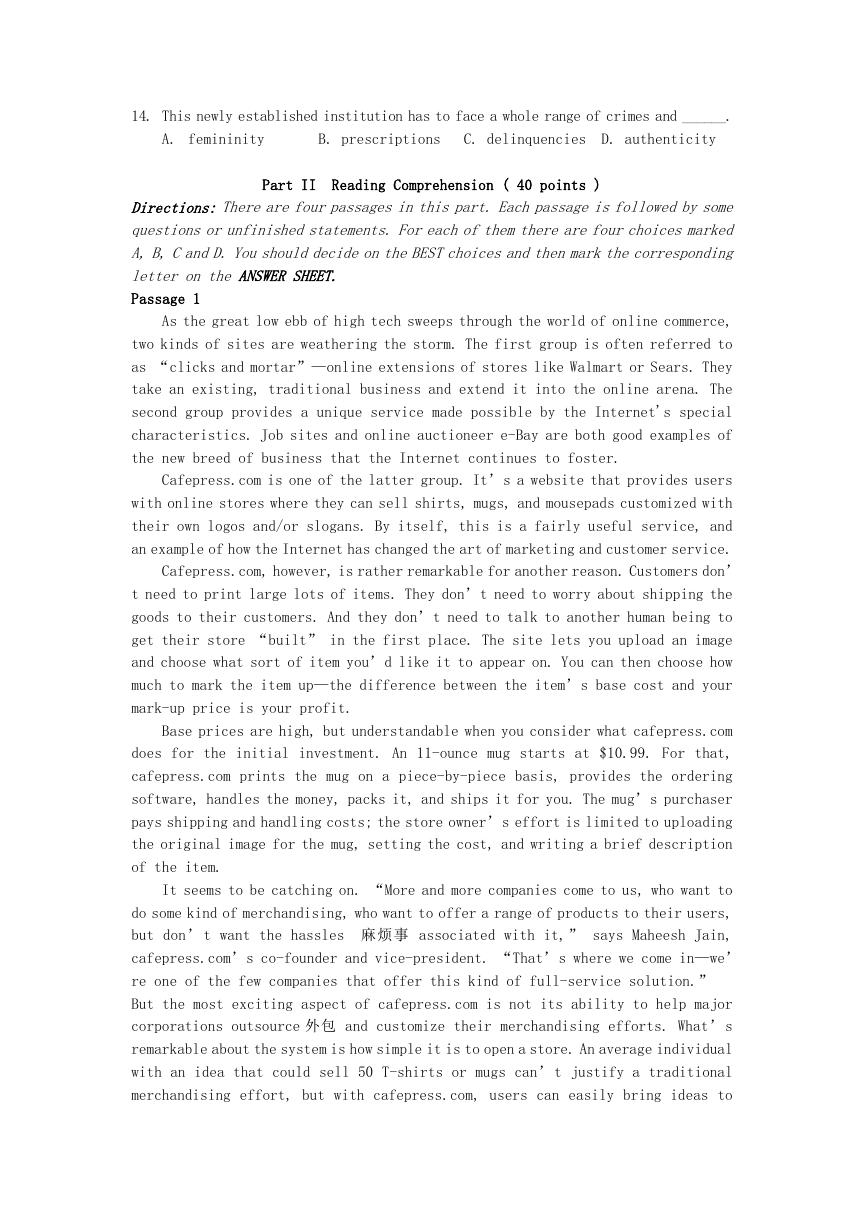
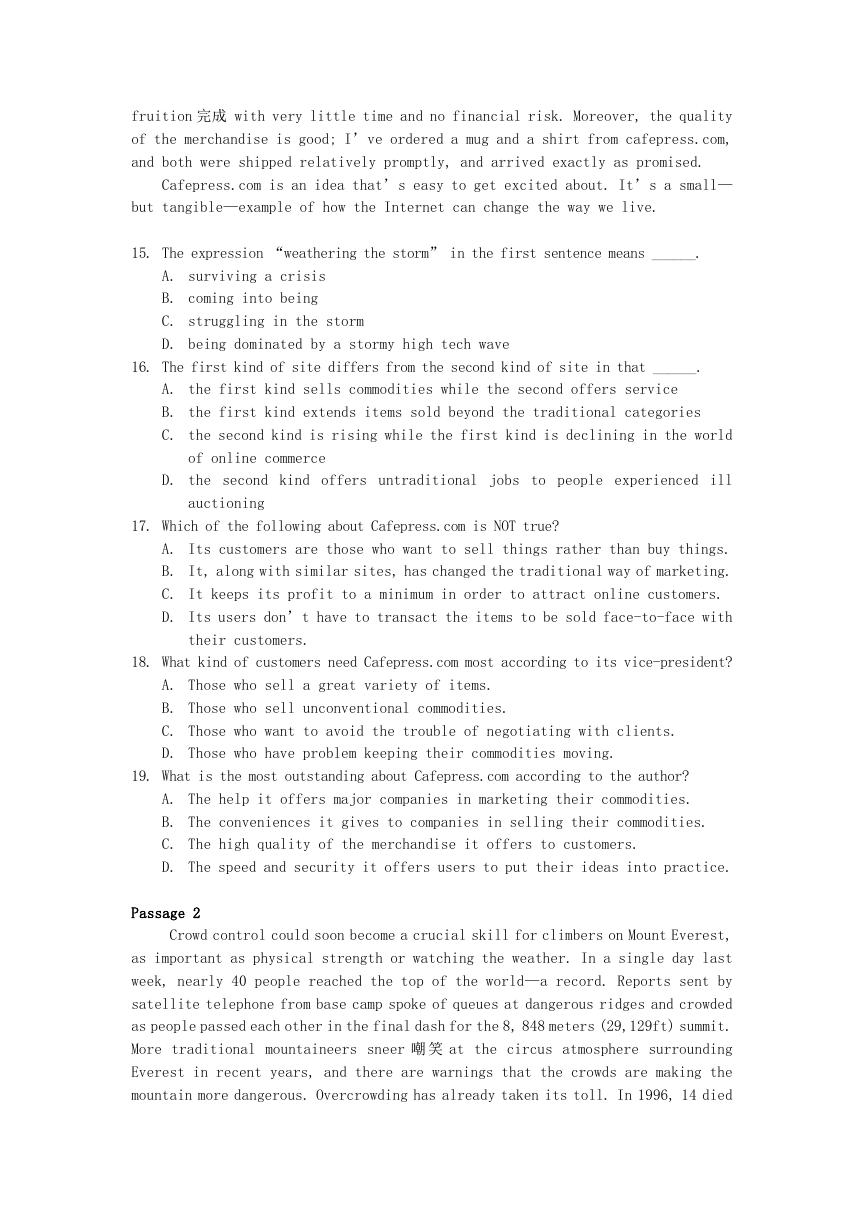
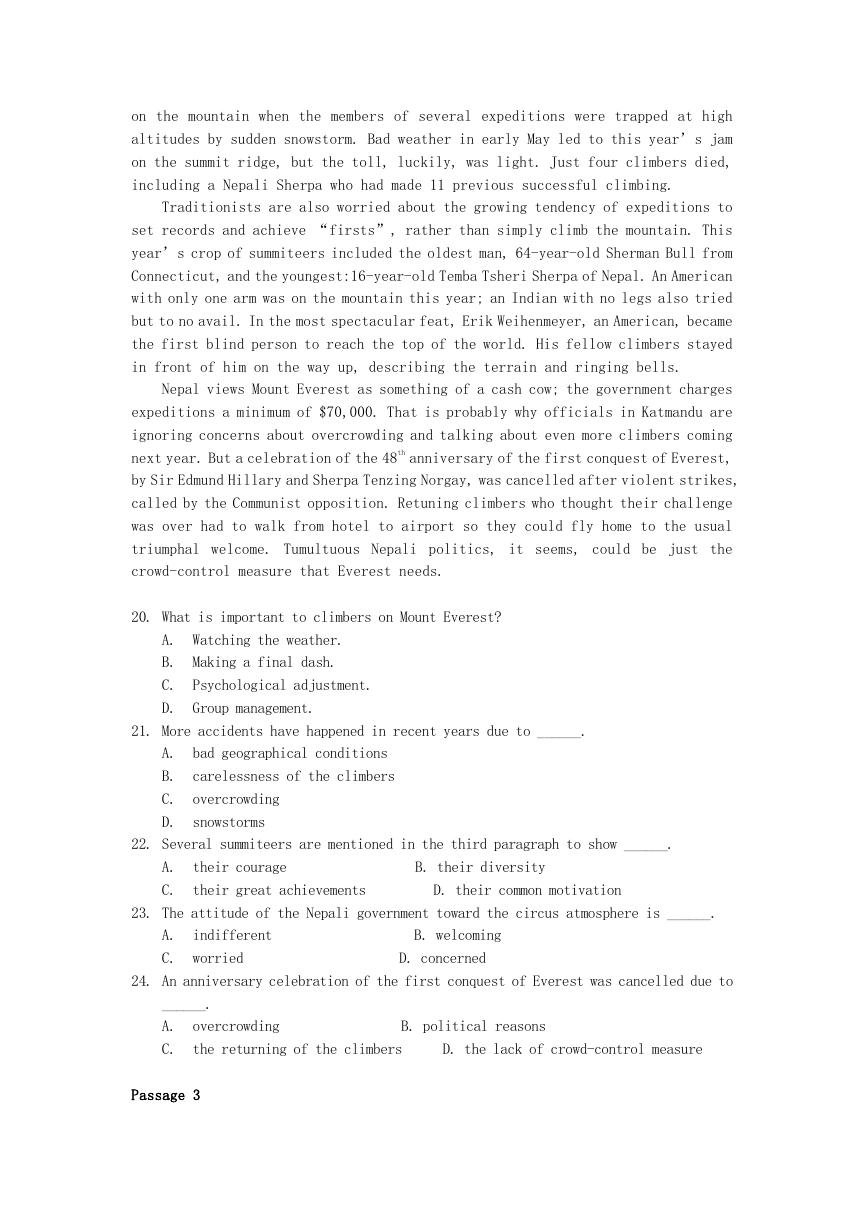
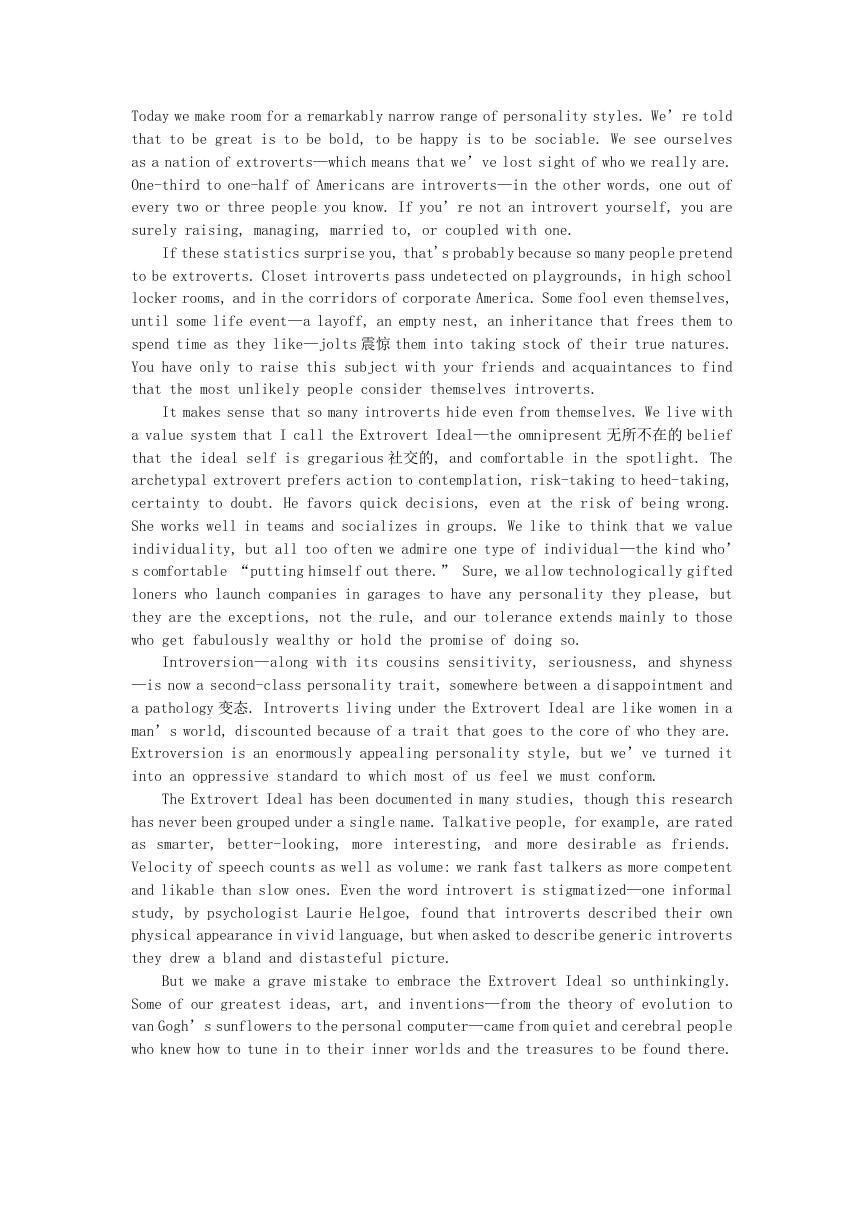
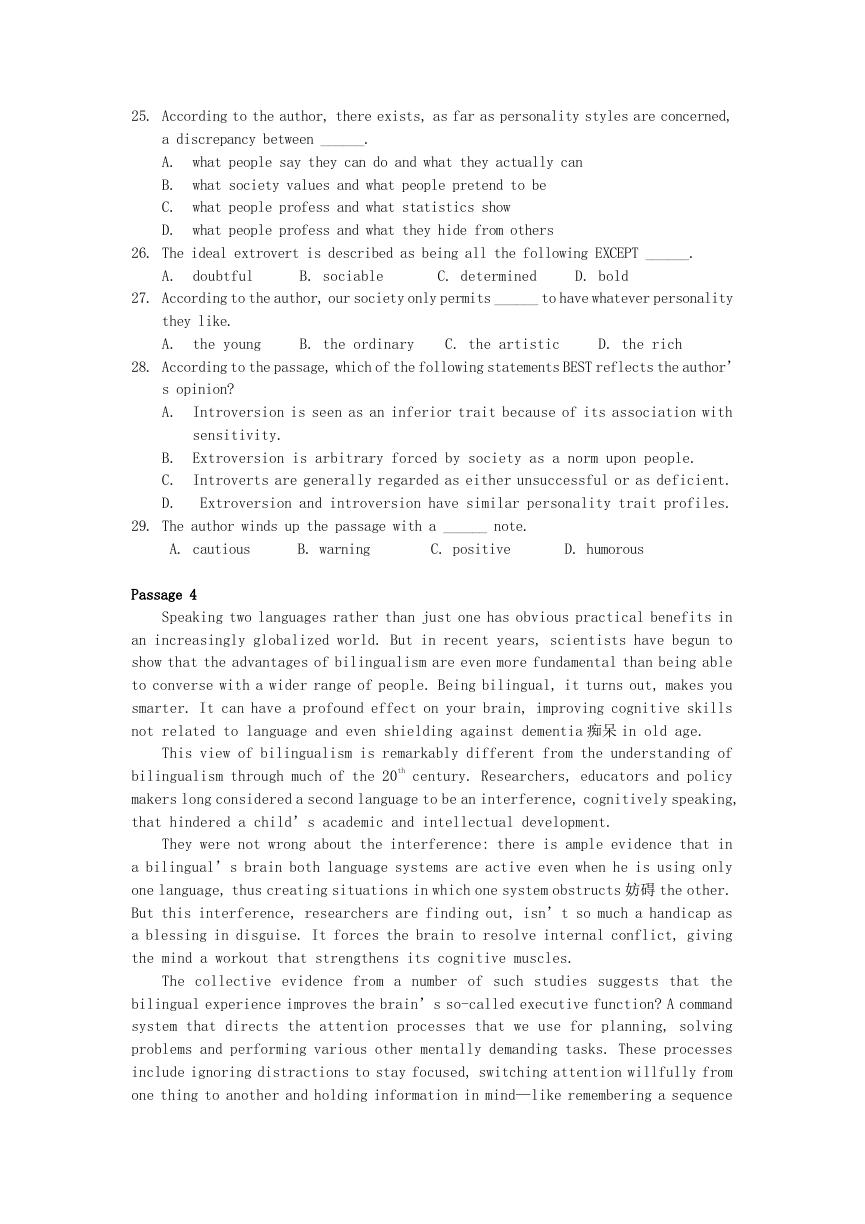










 2023年江西萍乡中考道德与法治真题及答案.doc
2023年江西萍乡中考道德与法治真题及答案.doc 2012年重庆南川中考生物真题及答案.doc
2012年重庆南川中考生物真题及答案.doc 2013年江西师范大学地理学综合及文艺理论基础考研真题.doc
2013年江西师范大学地理学综合及文艺理论基础考研真题.doc 2020年四川甘孜小升初语文真题及答案I卷.doc
2020年四川甘孜小升初语文真题及答案I卷.doc 2020年注册岩土工程师专业基础考试真题及答案.doc
2020年注册岩土工程师专业基础考试真题及答案.doc 2023-2024学年福建省厦门市九年级上学期数学月考试题及答案.doc
2023-2024学年福建省厦门市九年级上学期数学月考试题及答案.doc 2021-2022学年辽宁省沈阳市大东区九年级上学期语文期末试题及答案.doc
2021-2022学年辽宁省沈阳市大东区九年级上学期语文期末试题及答案.doc 2022-2023学年北京东城区初三第一学期物理期末试卷及答案.doc
2022-2023学年北京东城区初三第一学期物理期末试卷及答案.doc 2018上半年江西教师资格初中地理学科知识与教学能力真题及答案.doc
2018上半年江西教师资格初中地理学科知识与教学能力真题及答案.doc 2012年河北国家公务员申论考试真题及答案-省级.doc
2012年河北国家公务员申论考试真题及答案-省级.doc 2020-2021学年江苏省扬州市江都区邵樊片九年级上学期数学第一次质量检测试题及答案.doc
2020-2021学年江苏省扬州市江都区邵樊片九年级上学期数学第一次质量检测试题及答案.doc 2022下半年黑龙江教师资格证中学综合素质真题及答案.doc
2022下半年黑龙江教师资格证中学综合素质真题及答案.doc